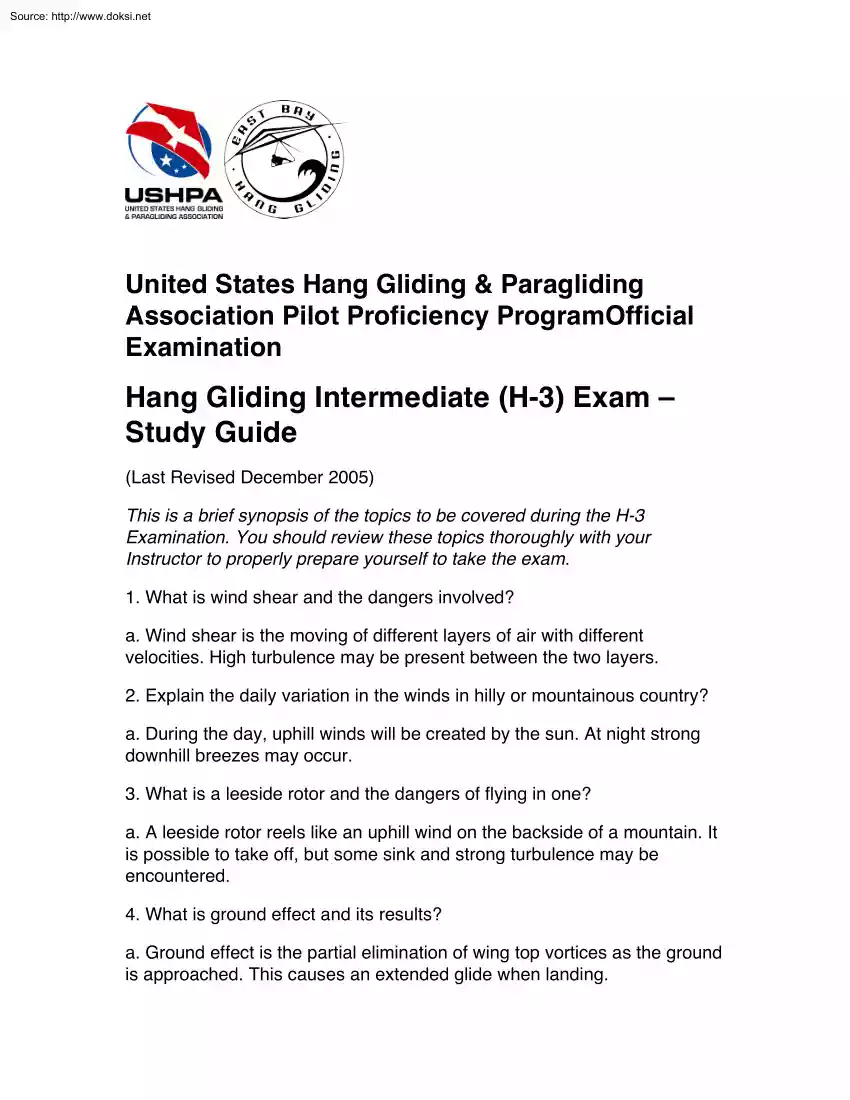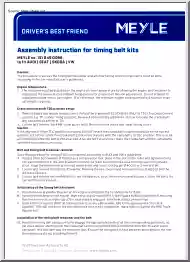Please log in to read this in our online viewer!

Please log in to read this in our online viewer!
No comments yet. You can be the first!
What did others read after this?
Content extract
Source: http://www.doksinet United States Hang Gliding & Paragliding Association Pilot Proficiency ProgramOfficial Examination Hang Gliding Intermediate (H-3) Exam – Study Guide (Last Revised December 2005) This is a brief synopsis of the topics to be covered during the H-3 Examination. You should review these topics thoroughly with your Instructor to properly prepare yourself to take the exam. 1. What is wind shear and the dangers involved? a. Wind shear is the moving of different layers of air with different velocities. High turbulence may be present between the two layers 2. Explain the daily variation in the winds in hilly or mountainous country? a. During the day, uphill winds will be created by the sun At night strong downhill breezes may occur. 3. What is a leeside rotor and the dangers of flying in one? a. A leeside rotor reels like an uphill wind on the backside of a mountain It is possible to take off, but some sink and strong turbulence may be encountered. 4.
What is ground effect and its results? a. Ground effect is the partial elimination of wing top vortices as the ground is approached. This causes an extended glide when landing Source: http://www.doksinet 5. What is the relationship of lift and drag to flying characteristics of a wing? a. The greater the lift to drag ratio, the better the glide path, but not necessarily the handling of the wing. 6. What is penetration?a A measurement of top safe flying speed of a particular kite. 7. What are thermals and how do they affect flying?a Thermals are rising parcels of air. They may be used to soar but are often turbulent 8. What conditions must exist for soaring?a The wind must have an upward component equal to the sink of the glider. 9. What are the problems encountered during cliff launching? a. There may be high turbulence at the launch site and a sudden lift on the nose of the kite as the air stream is entered. United States Hang Gliding & Paragliding Association Pilot
Proficiency ProgramOfficial Examination 10. What type of air should be expected on the back of a ridge or cliff? a Very turbulent, lots of sink. 11. What is the relationship of flying speed to bank angle and amount of forward push in a proper turn? a. A good turn is a precise coordination of entry speed, back angle and forward push. 12. What is the difference between air speed and ground speed?a Ground speed is the vector sum of air speed and flying speed. Source: http://www.doksinet References USHPA Part 104 Pilot Proficiency Program (SOP 12-2) USHPA Part 103 FAR-Ultralight Vehicles (SOP 12-4) USHPA Revocation/Reduction of Ratings Policy (SOP 12-7) 1995 Hang Gliding Accident Review Federal Aviation Regulation 91.111 Operating Near Other Aircraft 91113 & 91.115 Right of Way Rules 91.155 Basic VFR Weather Minimums UNDERSTANDING THE SKY by Dennis Pagen PERFORMANCE FLYING by Dennis Pagen Articles from Hang Gliding magazine: 4/80 pg. 48 5/80 pg 12 pg 32 5/81 pg 38 6/90 pg 46 The
Wind Gradient by John LakeA Ridge Soaring Primer by Rick LeeStalls by John LakeDoing a Hang Check is Not Enough by George Whitehill Launch T echnique by G.W Meadows This list is suggested reading and study material. Any additional suggestions will be appreciated.
What is ground effect and its results? a. Ground effect is the partial elimination of wing top vortices as the ground is approached. This causes an extended glide when landing Source: http://www.doksinet 5. What is the relationship of lift and drag to flying characteristics of a wing? a. The greater the lift to drag ratio, the better the glide path, but not necessarily the handling of the wing. 6. What is penetration?a A measurement of top safe flying speed of a particular kite. 7. What are thermals and how do they affect flying?a Thermals are rising parcels of air. They may be used to soar but are often turbulent 8. What conditions must exist for soaring?a The wind must have an upward component equal to the sink of the glider. 9. What are the problems encountered during cliff launching? a. There may be high turbulence at the launch site and a sudden lift on the nose of the kite as the air stream is entered. United States Hang Gliding & Paragliding Association Pilot
Proficiency ProgramOfficial Examination 10. What type of air should be expected on the back of a ridge or cliff? a Very turbulent, lots of sink. 11. What is the relationship of flying speed to bank angle and amount of forward push in a proper turn? a. A good turn is a precise coordination of entry speed, back angle and forward push. 12. What is the difference between air speed and ground speed?a Ground speed is the vector sum of air speed and flying speed. Source: http://www.doksinet References USHPA Part 104 Pilot Proficiency Program (SOP 12-2) USHPA Part 103 FAR-Ultralight Vehicles (SOP 12-4) USHPA Revocation/Reduction of Ratings Policy (SOP 12-7) 1995 Hang Gliding Accident Review Federal Aviation Regulation 91.111 Operating Near Other Aircraft 91113 & 91.115 Right of Way Rules 91.155 Basic VFR Weather Minimums UNDERSTANDING THE SKY by Dennis Pagen PERFORMANCE FLYING by Dennis Pagen Articles from Hang Gliding magazine: 4/80 pg. 48 5/80 pg 12 pg 32 5/81 pg 38 6/90 pg 46 The
Wind Gradient by John LakeA Ridge Soaring Primer by Rick LeeStalls by John LakeDoing a Hang Check is Not Enough by George Whitehill Launch T echnique by G.W Meadows This list is suggested reading and study material. Any additional suggestions will be appreciated.




 When reading, most of us just let a story wash over us, getting lost in the world of the book rather than paying attention to the individual elements of the plot or writing. However, in English class, our teachers ask us to look at the mechanics of the writing.
When reading, most of us just let a story wash over us, getting lost in the world of the book rather than paying attention to the individual elements of the plot or writing. However, in English class, our teachers ask us to look at the mechanics of the writing.